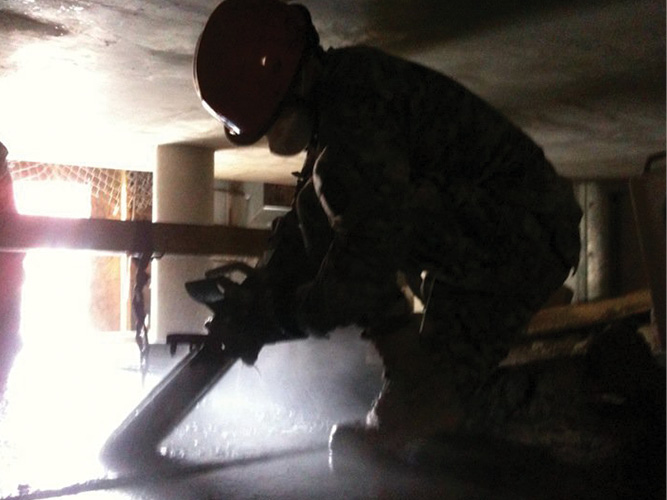
TRAINING NOTEBOOK ❘ By JEREMY RIFFLARD
Tornadoes, hurricanes, and earthquakes have been occurring frequently in the United States and elsewhere while terrorist attacks in Oklahoma City, New York City, and the Pentagon also have had devastating consequences. Residential homes, governmental buildings, commercial properties, schools, and other structures have been damaged and have collapsed from these natural and man-made disasters. Some of these structures are wood frame while others are steel and concrete. During these tragedies, local responders were burdened at the beginning of the rescue because mutual aid and state and federal resources can take hours or even days to arrive.
Firefighters, technical rescue teams, or urban search and rescue (US&R) personnel may be called to breach concrete walls and floors. Concrete can come in various thicknesses and densities and can be reinforced with additional layers of rebar for heavy loads. It may have additives that make the material lighter or denser based on the loads that need support.
Concrete floors that are poured for high-rise buildings are usually six to eight inches thick. Office buildings may have a nine- to 10-inch thickness in their poured concrete floors. Parking garage floors are thicker; they can be 12 inches and usually include double layers of rebar. These estimates of thickness vary based on column spacing, the load that the building will carry, and other considerations.
RELATED
Construction Concerns: Concrete—Modern and Ancient
Construction Concerns: Concrete-Reinforcing Steel
Construction Concerns: Wood and Concrete Composites
During our US&R team deployment to Haiti, there was an overwhelming number of collapsed structures that may or may not have had viable victims buried in the concrete rubble. Our squad quickly learned the value of making inspection holes in concrete; this method allowed us to see in void spaces. We could also monitor the interior atmosphere and search voids visually with search cameras. (For more on search cameras, see Fire Engineering, March 2016, “Seeing Beyond the Wall: Using a Search Camera.”)
To check a collapsed structure, rescuers will create an inspection hole for a gas monitor to sample the atmosphere. After they evaluate the atmosphere, they will insert a search camera to confirm the victim’s location and the structure’s stability. They may find a conscious victim who can relay his injuries to them or who can follow commands and move to a safe area during concrete breaching. Rescuers may then be able to move the breach point to a location where the unconscious victim will not be injured by falling debris.

(1) Task force members assess a pancake collapse of an apartment in Port-au-Prince, Haiti. (Photos by author.)
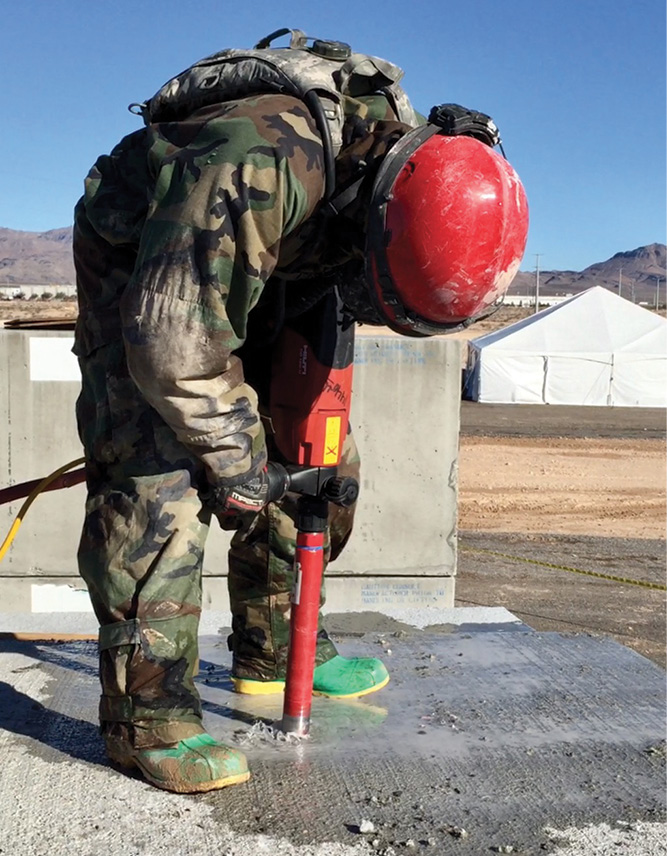
(2) A core drill creates an inspection hole for a gas monitor and search camera.

(3) A camera and monitors are used to monitor the atmosphere inside the concrete void space.
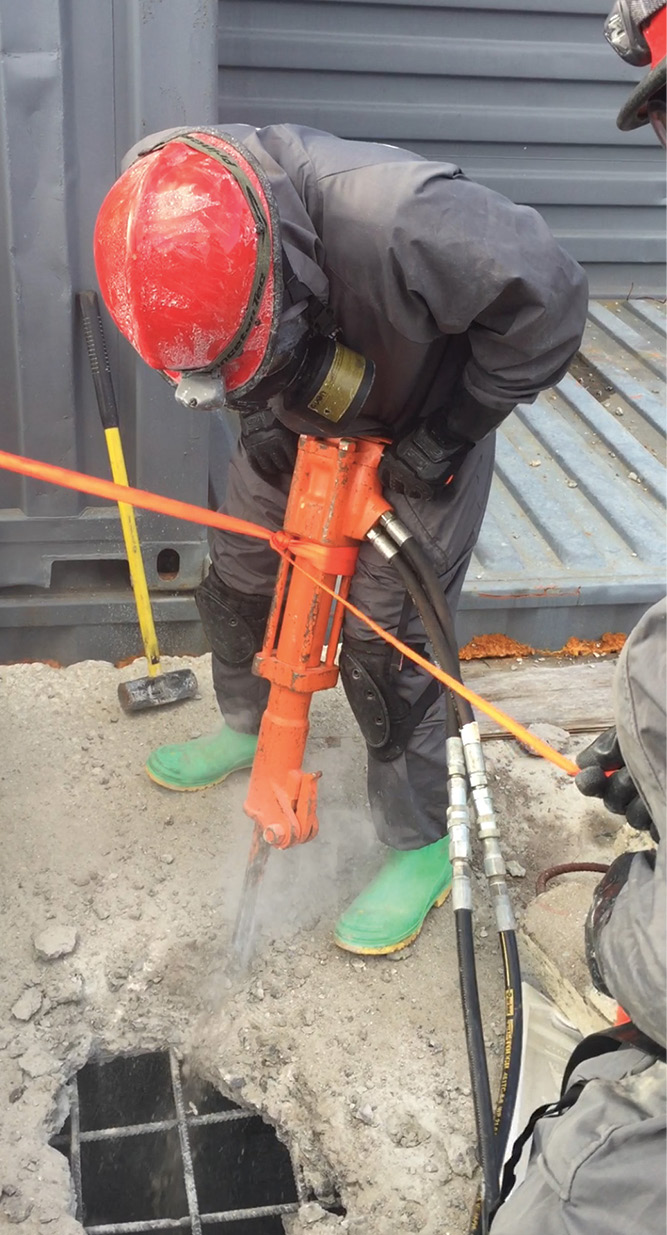
(4) Georgia rescuers use a 45-pound breaker for a dirty breach. Notice webbing is attached to the tool to prevent it from falling into the hole.
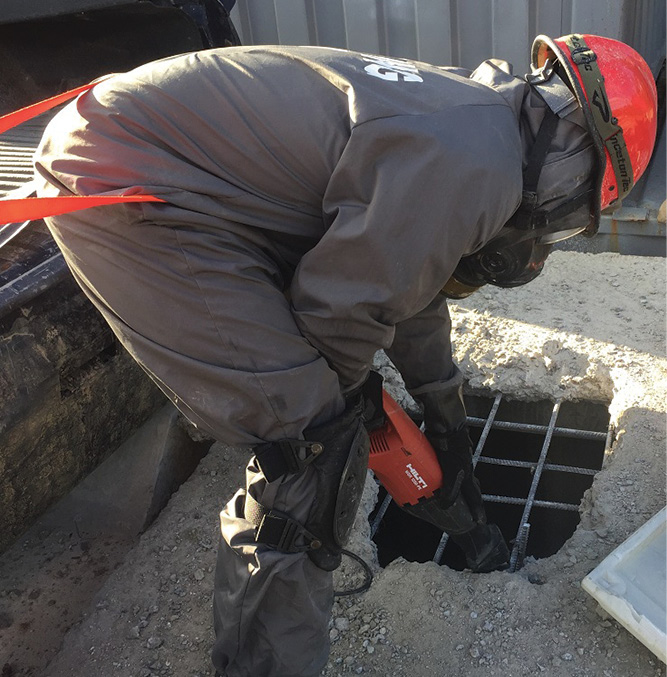
(5) A reciprocating saw is used to cut the remaining rebar. Webbing is tied around the rescuer to keep him from falling into the hole.
The Clean or Dirty Breach
When breaching a concrete floor, your primary consideration is the spot where the concrete will land. If there is no victim who can be injured by falling debris, then a faster, “dirty” breach technique is recommended. So, base your tool of choice on the need to execute a “clean” or “dirty” concrete breach. Several tools such as demolition breakers, hammer drills, pneumatic chipping hammers, cutoff rotary saws with a diamond blade, concrete chain saws, or hydraulic tools can break concrete floors. Evaluate the integrity of the structure. If there are significant cracks in the concrete components, avoid the tools that deliver a heavy impact.
Regardless of which technique you use, you must wear personal protective equipment (PPE) when cutting concrete. This PPE ensemble will include a helmet; eye, respiratory, and hearing protection; long sleeves; pants; and boots.
The dirty breach. For this procedure, rescuers break the concrete, usually with demolition drills or breakers, and then allow the concrete to drop. Although a victim must not be anywhere near the falling debris, it is recommended to have more manageable sized pieces of concrete drop instead of large, heavier sections that can compromise structural stability. One technique is to work toward the inspection hole, which is typically 24 inches square, making it larger as you chip away. Chipping will remove the concrete, but you must use another tool to cut the remaining rebar.
To make chipping easier, rescuers can add relief cuts in the concrete with rotary saws. Cut an “X” pattern across the 24-inch entry point. The relief cuts add break lines that weaken the concrete. Chip toward the relief cut with your tool at a 45° to 60° angle. If you chip downward directly into the relief cut, you risk the drill bit becoming stuck. If this happens, remove the bit from the drill and use a different bit to free the original one.
Consider the presence of carbon monoxide (CO) when using a gas rotary saw for relief cuts inside the structure. A buildup of CO can negatively affect the victim and rescuers, so have ventilation and atmospheric monitoring in place during this type of operation. A hydraulic chain saw is preferred for confined spaces.
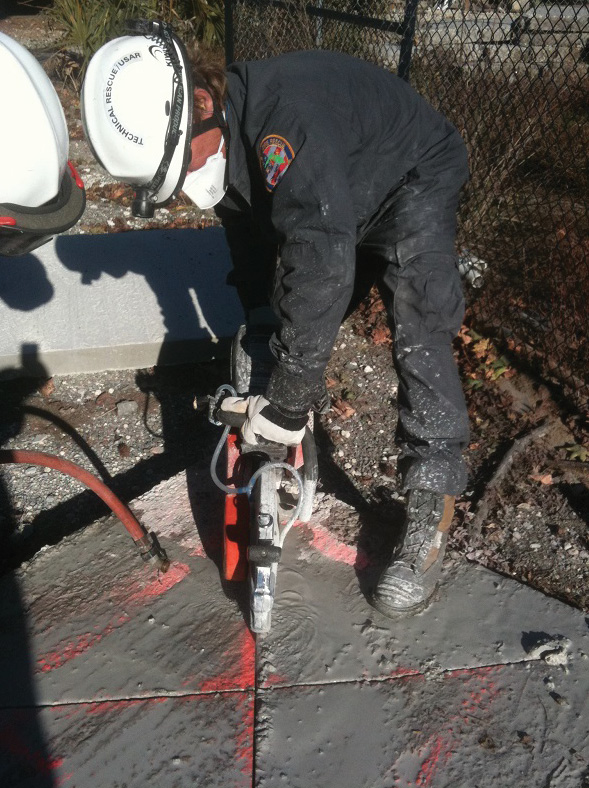
(6) Rescuers are making an “X” cut across the entry point to weaken the concrete in a dirty breach.

(7) Concrete is cut in a confined area with a hydraulic concrete chain saw. Ventilation is required to bring fresh air into the confined space.
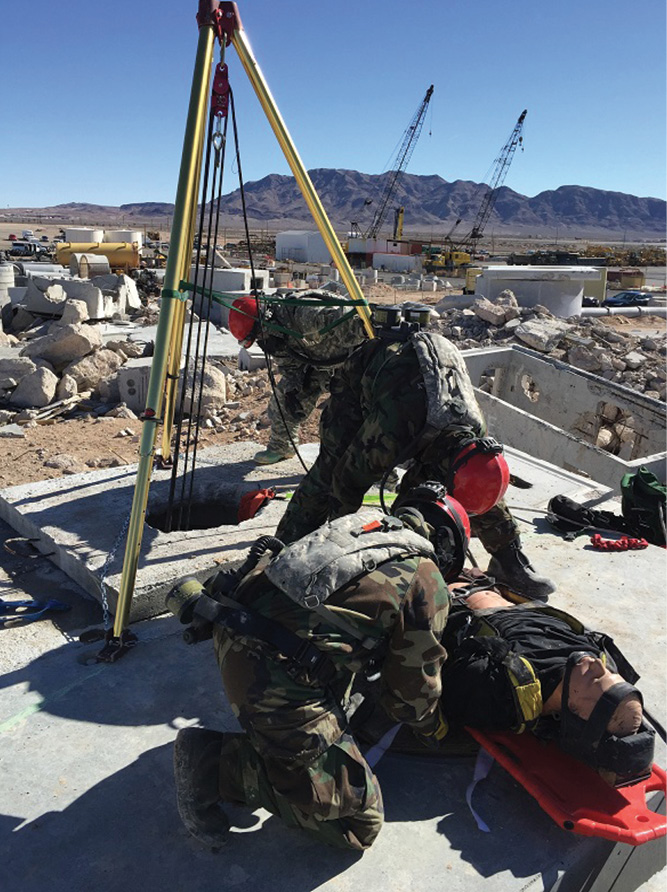
(8) Rescuers use a tripod to extract the victim from a lower level.

(9) During a Nevada training exercise, rescuers use a concrete chain saw with a diamond blade to cut through the full thickness of the concrete and rebar. The rescuer operating the saw has a webbing harness to prevent himself from falling into the hole he is cutting.
Cutting or chipping near an open edge can also be a safety issue. Rescuers near the edge should wear a harness that is tied off to prevent falling into the hole. As the tool breaks through the concrete and the debris falls downward, the pressure you put on the tool may cause it to fall into the hole. A leash may be an option for keeping a tether on your tool.
After you have breached the concrete floor, you may have a significant distance to drop to the floor below. The typical ceiling height of a building that has not collapsed could be eight to 12 feet, so you may need ladders, a tripod, or rope systems. Preplan how you will lower your rescuers and extract the patient.
The clean breach (and bevel lift-out). This “clean” breach is more controlled and time consuming than the dirty breach. The clean breach, bevel lift-out will consist of using a diamond blade rotary saw or diamond blade and a concrete chain saw to cut two parallel sides of your 24-inch-squared entry point.
The saw must be able to cut the thickness of the concrete with one pass of the tool. The concrete chain saw can cut the length of the blade—i.e., a 14-inch blade on a concrete chain saw can cut 14 inches of concrete. The rotary saw cannot cut deeper than the belt drive arm that holds the blade onto the tool. The arm reduces the depth of the cut of the 14-inch blade to about five inches.
If a victim is under the breach area, you must prevent falling concrete from injuring him. In this situation, hold the concrete in place as you cut. After the cut, move the concrete away without allowing it to fall. Angle the bevel cuts with the narrow side toward the center of your entry point, similar to carving a pumpkin top. The bevels will keep the concrete from falling inward.
After you make the two bevel cuts, stop and support the concrete to a four- × four-inch length of lumber that spans the entry point. Lay this piece of lumber across the cuts, and then use a six- to 12-inch length of rebar—girth hitched with webbing. Slip the rebar into the inspection hole, and then tie the webbing to the four- × four-inch lumber tightly with a square knot. If the webbing has slack between the lumber and the concrete, slide some cribbing under the lumber piece to add tension. Make the web tight so it will stop the concrete plug from falling inward. You can then place wedges in the gaps to prevent the concrete center from sliding downward. Your saw could get pinched when the center concrete settles, so keep the webbing and wedges tight to the lumber.
An alternative to using a rebar rod in the inspection hole is to use a wedge anchor. Drill a hole for a ½-inch wedge anchor, insert the expandable anchor, and tighten. Next, add a washer, nut, and lifting loop to the wedge anchor. The loop will be your attachment for the webbing described in the earlier step. The disadvantage of a wedge anchor is the possibility that the anchor will slip out of the hole you drilled.
After you have stabilized the concrete entry point to the lumber, proceed with the final two cuts, which can be either beveled or straight. Overlap the lines that you cut at each corner. The top of the concrete may appear to be fully cut, but the bottom of the concrete may not be cut through. Check the corners for overlap by inserting a reciprocating saw blade to verify that the cut is through the material.
When the cut is complete, the center concrete square may ease downward; this is a sign that the cuts are fully through the material. If the center is not settling, use a reciprocating saw blade to see which area was not cut completely through the concrete. Run the saw in the area that is still attached to finish the cuts. At this point, have two or three rescuers lift the lumber and move the concrete away from the entry point.
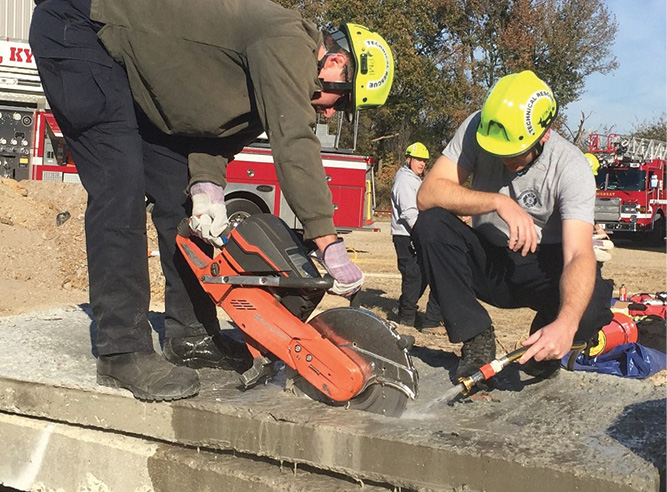
(10) This slab is four inches thick. The rotary saw can be buried up to the arm, which will give these Murray (KY) Fire Department (MFD) firefighters about five inches of depth during the cut. This will allow a clean breach, bevel lift-out.
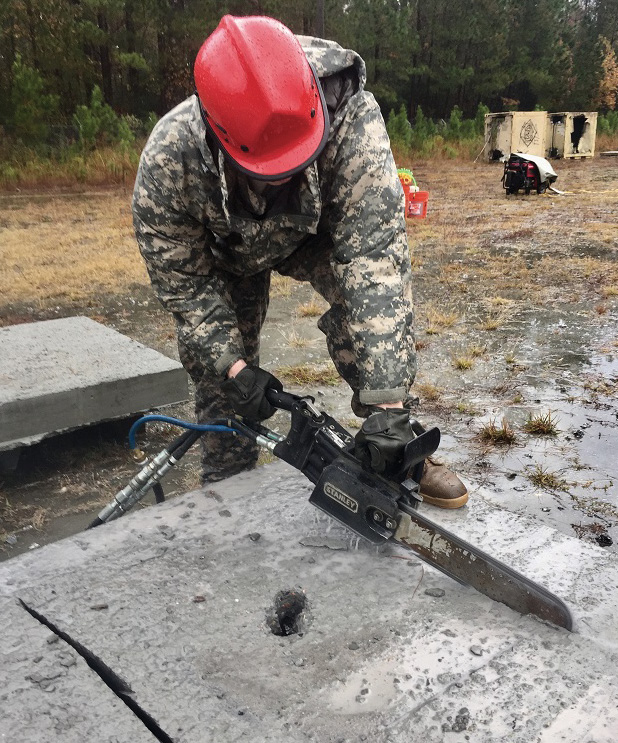
(11) This soldier is making a pair of parallel bevel cuts with the hydraulic chain saw. Score lines were cut over the spray-painted lines for the 24-inch access point. The painted lines were washed away by rain.

(12) A six-inch rebar rod is fed through the inspection hole and webbed to the lumber to secure the concrete in the bevel cut, clean breach.
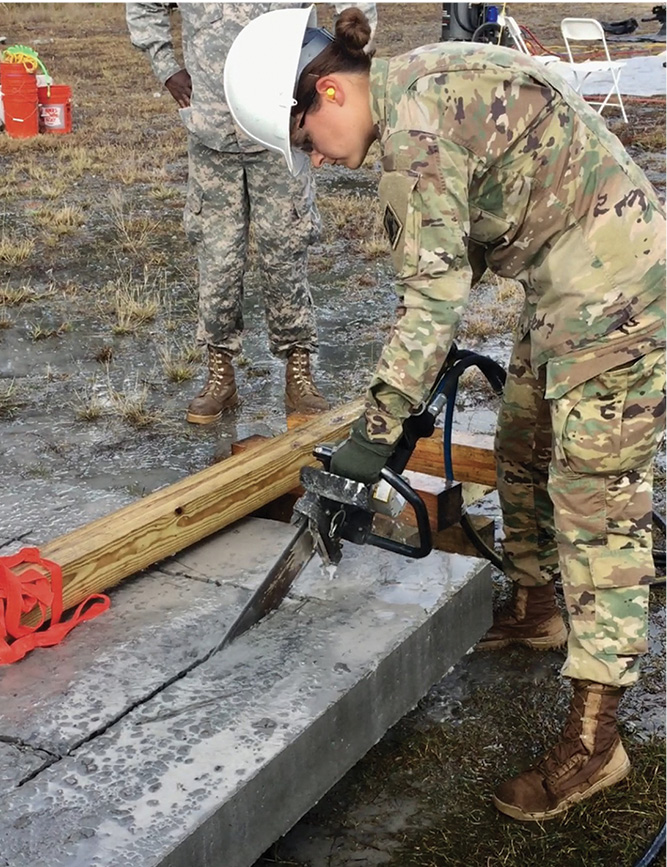
(13) The soldier is making the final two cuts with a concrete chain saw that can cut the full thickness of the slab.

(14) The soldier uses a reciprocating saw blade to see where the concrete has not been completely cut.
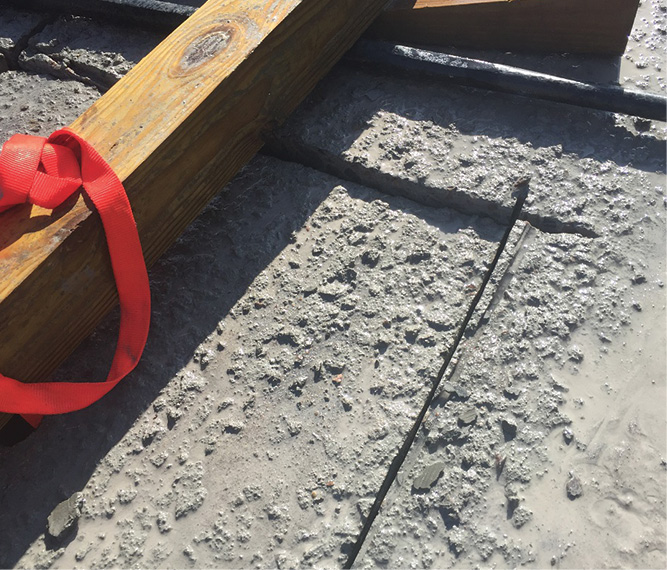
(15) The concrete has been cut completely and has settled downward in the corner, which is a sign that you have cut through the full thickness of the slab.
The Clean Breach Step Cut
Insert a search camera into the inspection hole to identify the victim’s location. The camera will tell you much about the victim, the structure, and the best access route. The inspection hole will give us an access route to sample the interior atmosphere with a four-gas monitor.
A typical gas power saw carried by most fire companies has a 14-inch blade and features an arm with an arbor that holds the blade onto the saw. Because of the arm, the saw cannot cut greater than about five inches deep. If the concrete is less than five inches thick, you will not have a problem, but what do you do if you need to cut concrete that is eight inches thick?
To defeat thick concrete with a clean breach technique, the Federal Emergency Management Agency’s Structural Collapse Technician program proposes a “step cut.” Begin the process by marking the area with an 18-inch center square around the inspection hole. Mark a larger box that is 10 to 12 inches wider than the first box. Extend the inner box lines in each direction to create a grid of nine boxes. You will need water to cut concrete with a diamond blade tool. Rain or the water used to protect the blade may wash off the spray paint that marks the area that will be cut. It is a good practice to use the saw to cut 1⁄8-inch score lines over the paint.
Use the rotary saw to make deep relief cuts along the marked lines (the saw should give you a five-inch depth into the concrete). Also, use water to protect the diamond blade during the cut; the water reduces the dust created from the cut. Consider water runoff because you do not want to aggravate the victim.
Next, use chipping hammers to chisel a trough around the center square. Do not penetrate too deep or you may break the concrete in an uncontrolled manner. Chip the channel to a consistent five-inch depth.
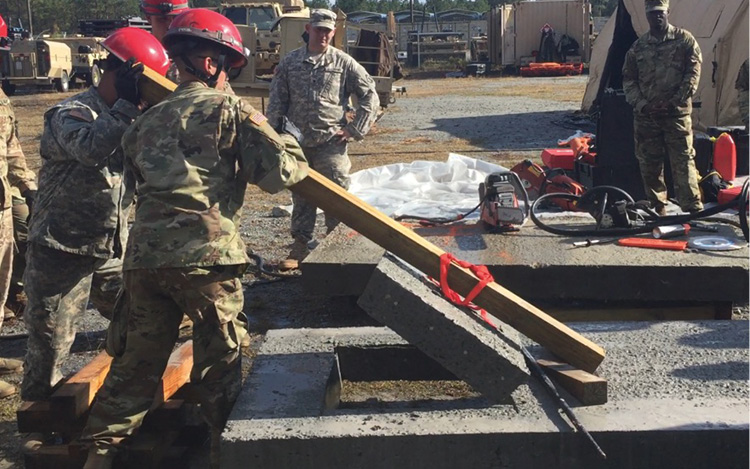
(16) Rescuers lift the four- × four-inch lumber like a lever to remove the beveled concrete plug. (
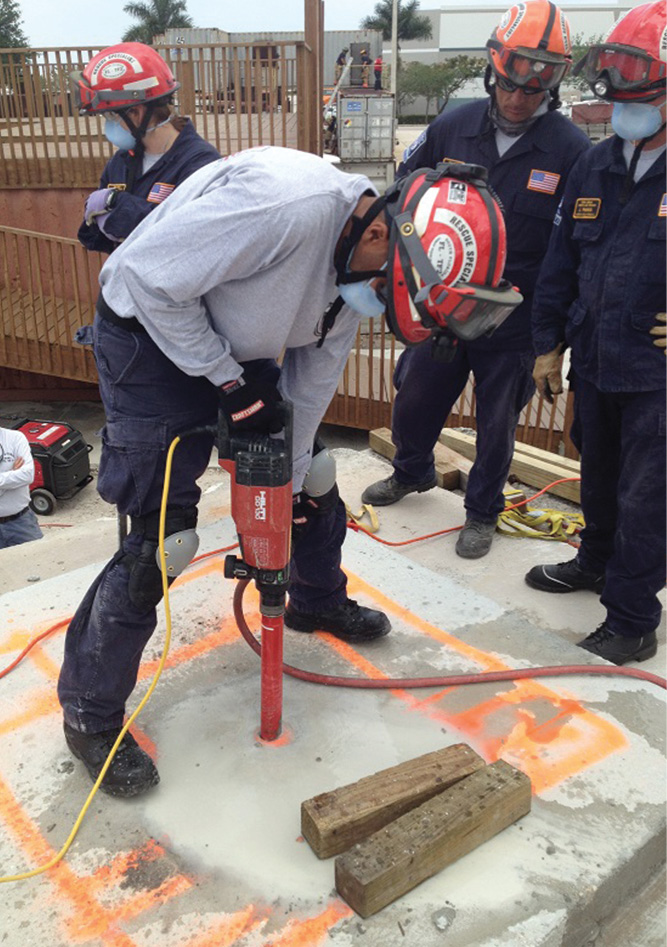
(17) Task force members use a core drill to create an inspection hole.
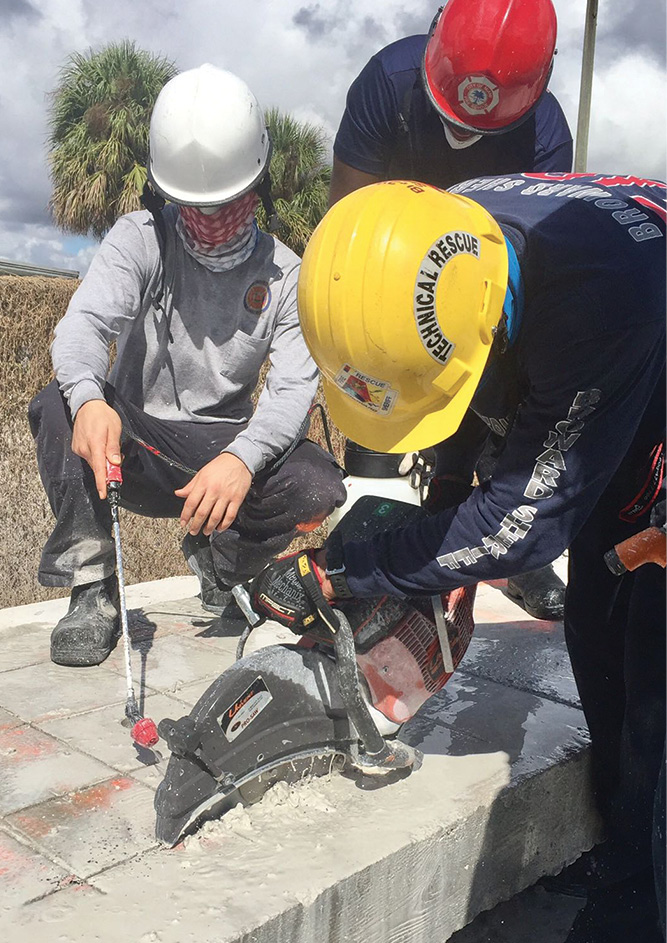
(18) After the concrete is marked to form nine rectangles, firefighter students at the Coral Springs (FL) Regional Institute of Public Safety use the saw to cut relief cuts along the grid.

(19) MFD firefighters chip concrete to create a channel. This lower level will allow the saw to fully penetrate the concrete on the next pass.
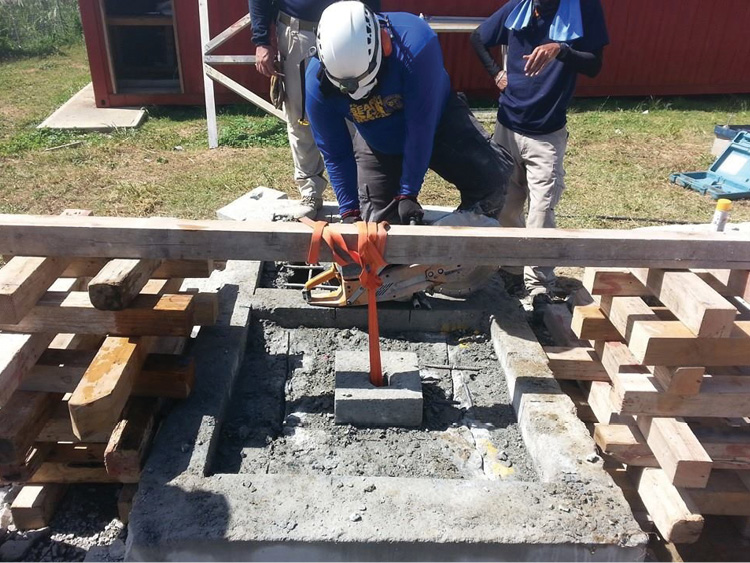
(20) Rescuers from Puerto Rico are using rebar inserted into the inspection hole to support the concrete.
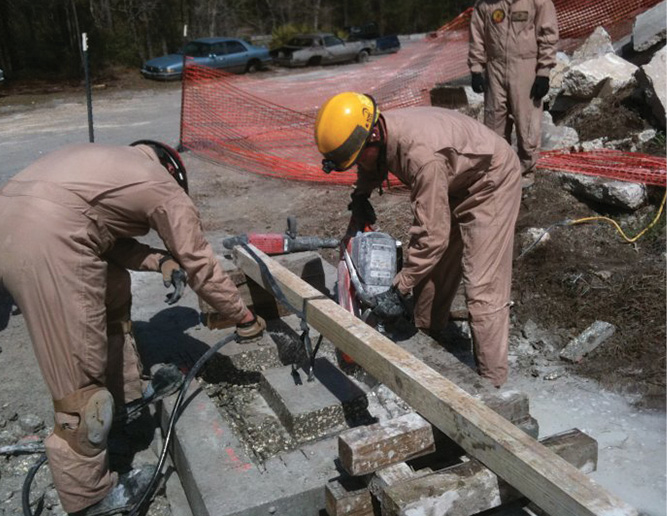
(21) Marines are using a wedge anchor to support the concrete.
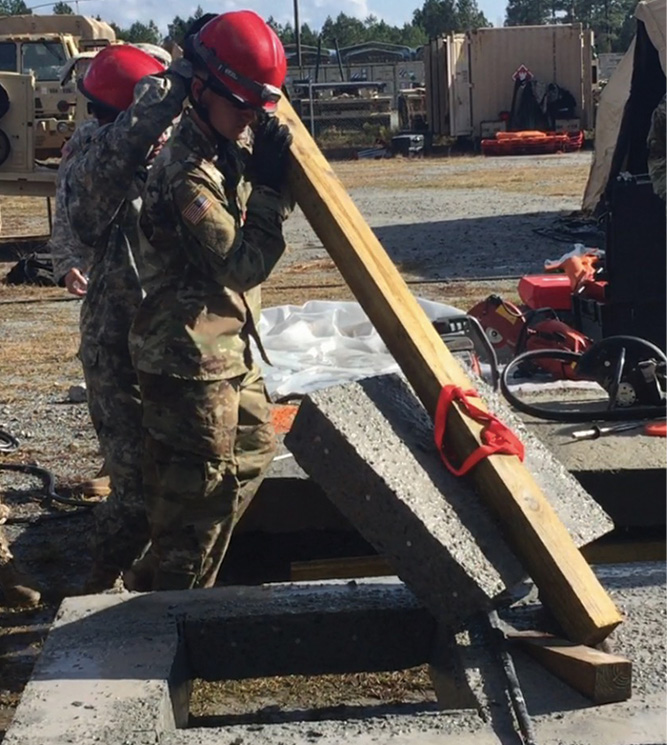
(22) Rescuers lift the concrete away from the access hole.
After the trough has been chipped, make two parallel bevel cuts in the channel with the rotary saw. The center area of the concrete will eventually become the access hole. Support this section with lumber to prevent it from falling into the void space. Next, place the lumber over the two parallel cuts. Girth hitch a six- to 12-inch piece of rebar with webbing and insert it into the inspection hole. Tie the webbing around the lumber with a square knot.
Last, make the final two cuts to complete the access hole. When the cut is complete, you may see the center concrete square ease downward. This is a sign that the cuts are fully through the material. At this point, have two or three rescuers lift the lumber and move the concrete away from the entry point. This section of concrete weighs between 100 and 300 pounds. Do not overengineer the system to remove it. Use the lumber as a lever.
Concrete structures are some of the most difficult to breach, so understanding the ways to weaken concrete can help you breach this material safely. Your jurisdiction may be the first to respond to a major disaster. Locate victims and determine the best way to access them. Decide if a clean or dirty breach will be needed. If you train on the techniques to breach concrete, your team may be able to make advanced rescues. Your community is counting on somebody to help, so be that department that makes the difference.
JEREMY RIFFLARD presented on swing-stage scaffold rescue at FDIC International 2019. He is the lead instructor for the Scaffold Rescue Program at the Coral Springs (FL) Regional Institute of Public Safety. Rifflard is also the program manager for his company TechnicalRescueTraining@yahoo.com. For the past 20 years, he has been the subject matter expert with L2 Defense for first responders and military urban search and rescue exercises. He is a captain with the Fort Lauderdale (FL) Fire Department and a rescue team manager for the FEMA Urban Search and Rescue Team FL-TF2. Rifflard’s most recent task force deployments were to the Haitian earthquake and the 2018 Hurricane Michael in Mexico Beach, Florida.

